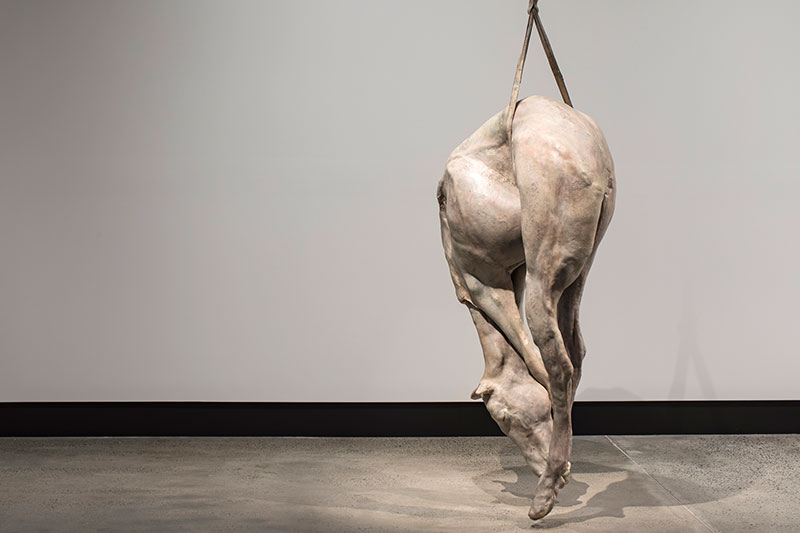
This exhibition, or more correctly, project comprising a collection of four individually curated exhibitions, signals the ambitious and elusive search for the origin of art, with all its attendant fascinating and frustrating complexities.
My first of many visits to MONA to engage with this massive project was unmediated by text or recordings. After all for me, the first evaluation of an exhibition should focus on the nature of the sensory experience, words and theories can come later. The show is full of impressive and rich moments on a large immersive scale in the form of installations such as Yayoi Kusama’s Dots Obsession – Day, 2008, which predictably overwhelms the senses, Aaron Curry’s sensory colour overload Daft, Dank Space of 2013, and a room of mutated and morphed figurative forms including Henry Moore’s Helmet Heads, Barbara Hepworth’s cool biomorphic abstractions, a Patricia Piccinini collection of mutants and hybrids and Berlinde De Bruyckere’s bereft waxes depicting suspended and slumped boneless bodies. It also delights with small but intense moments at every turn such as Oba Bronze heads, glorious bird’s wings, ancient and primitive jewellery and artefacts, stunning butterflies and a compelling video of tiny spider sexual displays (Maria Fernanda Cardoso). Add to this the shock effect of work like the series Not a Rose 2010 by Heide Hatry in which exquisite flowers are formed from animal body parts, and Jeff Koons’ Manet 1991 in which the artist performs cunnilingus on his then wife, pornstar Ilona Staller (AKA “Cicconlina”), and there are plenty of head-turning moments.
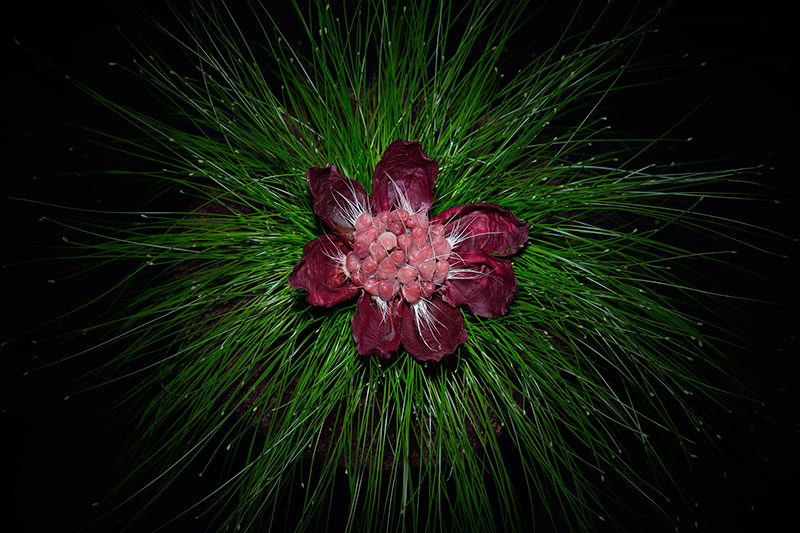
Attempts to glean the propositions of each curator were less immediate in impact, except perhaps for the selections of Geoffrey Miller in which sex and eroticism pervaded his spaces. I had not expected much more to be revealed from direct contact with the work, particularly since it should be the relation of one work to another which would perhaps elicit some thematics and with such a vast amount and range of work and so many potential readings only certain subsets of the curators’ theories emerged clearly – like pattern, movement (dynamism) and display.
MONA Director and entrepreneur David Walsh is not afraid to ask big questions, more so the difficult ones. And in this, MONA ’s latest and to-date largest major exhibition project, he does both. Here, he seeks to tease out and explain the major forces that drive “art”, enlisting the support of four non-art experts, working across different disciplines. Those interdisciplinary curators are linguist and cognitive scientist Steven Pinker, psychologist Geoffrey Miller, evolutionary neurologist Mark Changizi and professor of literature Brian Boyd.
Walsh has stated many times that one of the key motivations behind the development of MONA’s collection was his belief that most art is essentially driven by two things – Sex and Death. There are many levels on which this belief stands up, particularly if we assume that Eros drives us from the Id forcefully and relentlessly (despite the many levels of sublimation and perhaps even obfuscation that attend its expression), and that Death is another inevitable driver in the form of a consciousness of mortality played out in the desire to express individual personality and intellect, not to mention the creation of something which may transcend the life span of any single human being.
A further clue to Walsh’s position is in the title itself, referencing Charles Darwin’s On the Origin of the Species. Walsh’s respect and admiration for Darwin is no secret and this suggests that of the four positions it is biological determinism which is most central to the exhibition, with a section of the massive catalogue summarised as “Art and nature-harnessing” that is close to his heart. Walsh states emphatically that art isn’t a cultural phenomenon and he’s pretty sure it’s universal. He seeks to determine what art is by turning away from cultural and political definitions to instead focus on observations of its genesis in the deepest and most primal sources and according to the most primal impulses. In his catalogue foreword he writes “To understand what art is, we first have to understand why it is that we make it.”
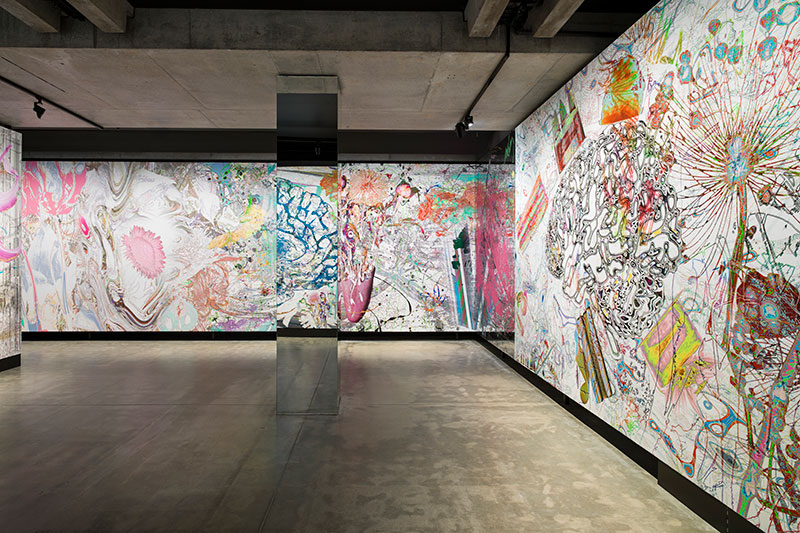
Since art historians and academics consider art primarily within the frame of culture Walsh has no use for them in an enterprise such as this; rather, he needs to test if those with insights into evolution can consider art from an alternative generative point of view since it too conforms to the imperatives of evolution.
Each curator selected works of art (over 230 in all) from a wide range of sources: Walsh’s collection, national and international institutions (58 in all) and private collections, and as nine new commissioned works, directly from artists. The museum space was then divided into four zones, each with its own entrance. The visitor approaches four doors, each with a unique cryptic visual device. They are like four rabbit holes – all with quite different internal plans. Any memory one may have had of previous arrangements of the internal space of this level of the Museum disappears immediately. Entry into the adjacent doors provides access to entirely new spatial configurations determined by the unfolding of each thesis and the display requirements of the individual artworks.
Stephen Pinker cites the nine criteria defining art listed by Dennis Dutton, (a philosophy professor and editor of Arts and Letters Daily whose book The Arts Instinct proposed that humans are hard-wired to seek beauty), as a starting point for his analysis and considers that art (like reading) is not a specific biological adaptation but is a by-product of adaptations, primarily to gain status. His selection includes artwork centralised around beauty and erotica. But his somewhat limiting definition of “aesthetic”, referring only to beauty and the flower as a representative example of both through its intimations of fecundity, highlights this less-than-satisfactory recourse to an alternative disciplinary origin. Somehow his explanation of why we find flowers beautiful and fascinating is unconvincing yet it is delivered without question, arising more from logical deduction. That we find a flower fascinating is surely more than that: as he asserts, they are potent biological cues for selecting a productive environment since they can evolve into fruit. This somewhat simplistic reduction is unproven and contentious. Perhaps our fascination with Landscape as a genre on the basis of the same criteria is a little easier to accept. His overall discussion of pattern as a cornerstone of art as a pleasure technology is nonetheless convincing and well exemplified in his choices, including examples of Beauty and Status.
Geoffrey Miller strongly espouses the theory that art evolved through sexual selection, a reasonable assumption since we are considering how and why it evolved, regardless of what it has become. “If a theorist isn’t invoking signalling theory when talking about the evolution of a signalling system like human art, you know they’re trying to spin a rivulet of feculence into a pearl necklace.”
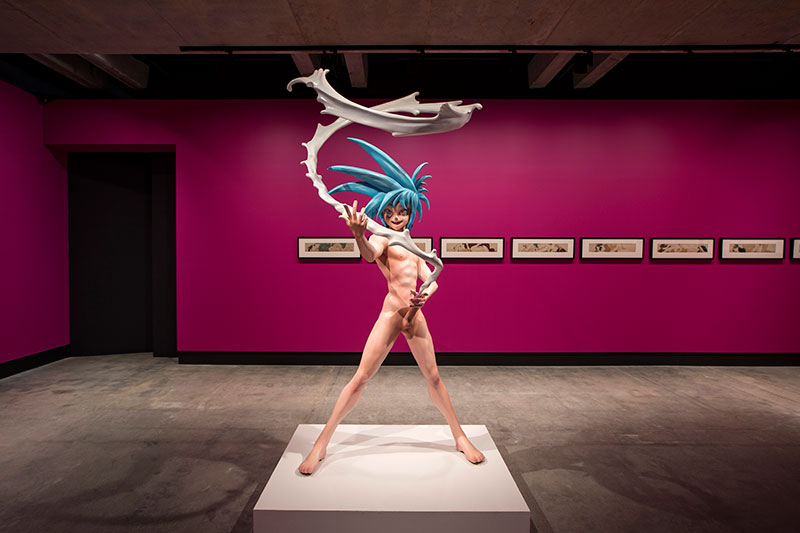
Miller makes a clear distinction between the “signaller” and the “receiver” and how much easier it is to analyse the receiver’s response than the signaller’s motivation, yet most of his selections inevitably exemplify the latter rather than the former. A key issue arises at this point. The selections of these scientist curators constitute selected evidence of each theoretical position but the question then arises as to how extensive this evidence needs to be to make the point. As exhibition experiences, things tend to be predicated on the evidence aspect rather than the homogeneity an art exhibition can present when the objects have other functions over and above a catalogue of examples and this is perhaps where a crucial distinction emerges between creative curating and comprehensive museological evidence presentation.
This is clearly a museum experience rather than a stimulating and thought-provoking curatorial adventure. The theories are thought-provoking but the actual exhibition experience at the level of an engagement with works of art is not. Miller’s selections run the gamut from a selection of spiders, the displays of bowerbirds (supporting Darwin’s theory that art evolved before humans, at least from the point of view of the receiver as aesthetically sophisticated), through Hokusai’s images of a female diver being pleasured by an octopus to the manga sculpture of Takashi Murakami in My Lonesome Cowboy (1998).
The one question lingering is that we cannot accept Darwin’s construction easily since the convincing argument remains that art is a human construct and not simply a function of aesthetic response to a form evolved without conscious intention. If we take the name of art for this conscious creation process then the evolutionary unconscious development is truly something other than art, despite the fact that we may react to it, or that it may even function in similar ways. We must be able to formulate a clear conceptual distinction between these two things. The question is left hanging.
Brian Boyd offers the commission Dots Obsession – Day by Yayoi Kusama to announce the five aspects central to his position regarding the theme – coevolution, pattern, play, control and attention. Coevolution refers to the fact that the development of much of her work is in response to audience engagement. His primary argument is simple and convincing, citing biologist Richard Prum’s position that “any human product that coevolves through the interplay of makers’ efforts and appreciators’ aesthetic preferences falls within his generous notion of art.”
This is a satisfying, comprehensive and convincing position indeed, based on the fact that the selection is guided more by taste than function. Within Boyd’s broad selection all the elements are held together under this definition and its sub-sets and are comfortable in their diversity. Natural animal and plant patterns, ancient tools, crafted beyond their functional requirements, body painting, graffiti art, cartoons, flint axes, Hokusai’s Great Wave, African bronze heads, Islamic tile patterns, Andy Goldsworthy, (represented here only in photographs) and a sarcophagus from Walsh’s collection all sit and fit under Boyd’s generous interpretation. But inevitably, with so many categories to represent with examples, the various elements still cannot communicate with each other coherently, except as evidence. We are still in a museum.
Mark Changizi’s approach is based primarily on his concept of nature-harnessing. He explains it thus: “My exhibit at MONA is about a revolutionary third option (beyond nature/culture). It is called “nature-harnessing”, a theory on the origins of art that is neither biological nor cultural.”
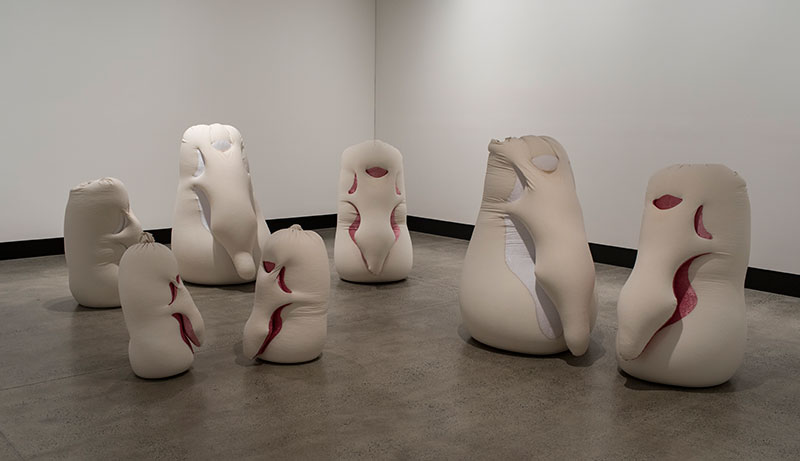
Changizi regards works of art as part of the plethora of “stimulus-artefacts” that humans are capable of responding to. This represents a major leap in brain plasticity beyond the narrow frames of reference that animals respond to. Art is the product of cultural selection, not natural selection; it is learned not instinctual. Put simply the way humans process natural forms into language – letter forms in particular is by associating the development of the form back to the natural forms we are already encoded to detect and recognise. The same is apparently true of musical forms. This is then the basis of the full array of stimuli that we respond to. This carries over into the recognition of forms that are shifted into the abstract, not just recognisable figurative forms.
Changizi illustrates his theory with a wide array of forms which are predominantly figurative in their origin but have morphed or shifted into abstracted constructions: Henry Moore’s helmet heads, Ernesto Neto’s wearable fabric objects, Barbara Hepworth’s organic abstract sculptural forms, Patricia Piccinini’s various mutated and hybridised drawings and sculptures and Berlinde De Bruyckyere’s disturbing wax constructions, as well as a commissioned installation from Brigita Ozolins based on letter forms and an interactive light and sound work from UVA which responds to body movement. I found Changizi’s selections to tie most directly and therefore most convincingly to the expression of his theory than the other exhibitions.
It is interesting to see objects from the Walsh collection more than once, in a variety of exhibitions, each time assigned to different evidentiary functions. This serves to demonstrate the many meanings or theses a single object can potentially support depending upon how it is contextualised. Each of the major MONA shows thus far seems to be determined by Walsh’s ongoing desire to learn more about art while justifiably opening out the art discourse into a non-art academic, non-cultural theory space. Accepting that there may be no definitive answers to the questions of what art is and what its origins may be, passionately argued and contested theories can be considered a more than satisfactory outcome. After all art is not a discipline but an open space for discourse and proposition after all.
